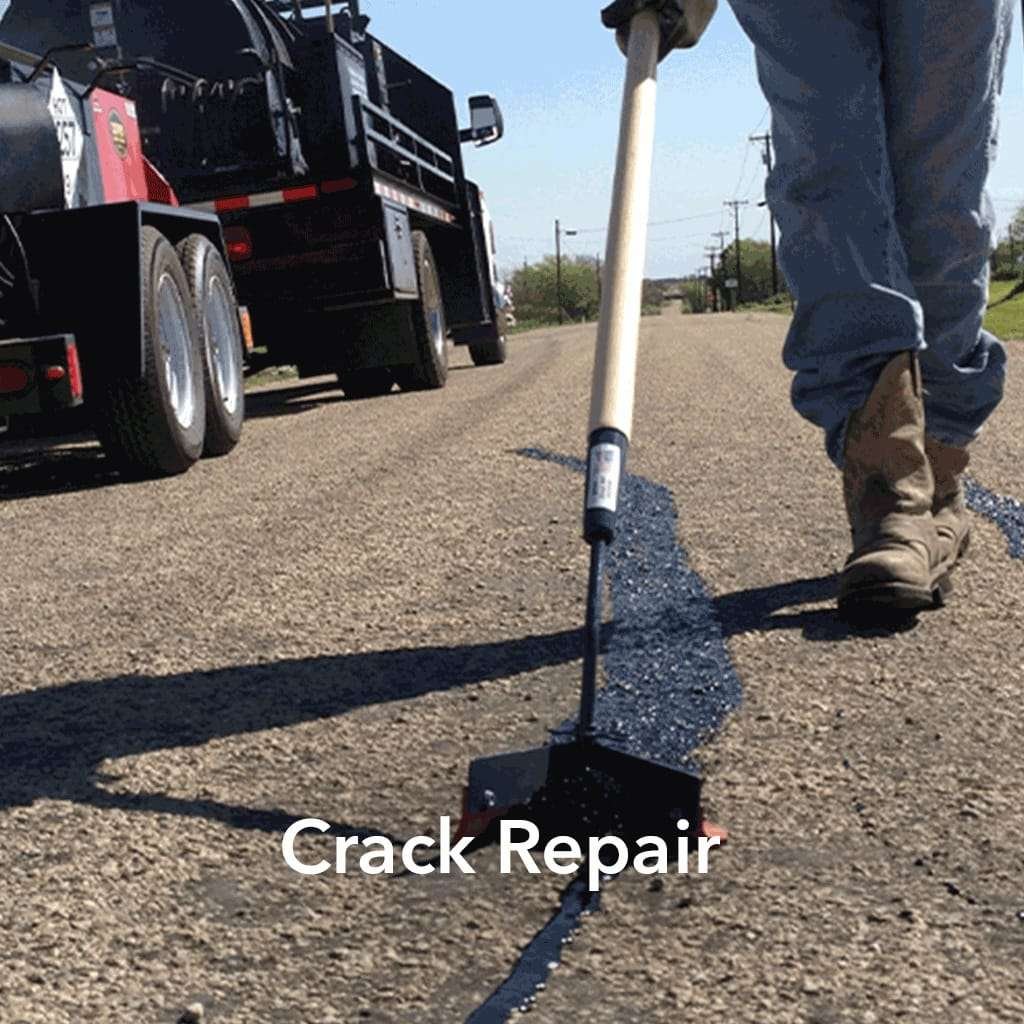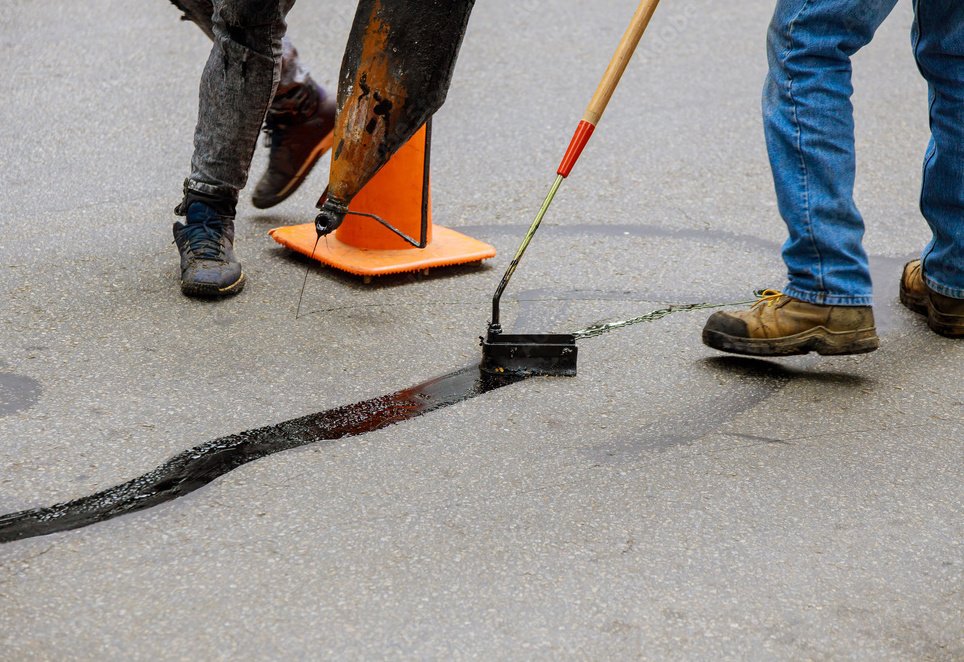What is Crack Filling - All You Need to Know
Crack filling is a crucial aspect of maintaining the health and longevity of pavement. This blog post will help you understand crack filling better. The discussion will cover why they form, why maintenance is important, how to do it, and when you should do it.
Knowing about crack filling can help you protect your investment and keep surfaces safe and smooth.
What is Crack Filling?
Crack filling is a common service for maintaining pavement. It helps prevent water and debris from seeping into the base layers of asphalt. This is arguably the most important maintenance activitiy someone can do for their parking lot. Not filling cracks causes significant pavement deterioration over time.
This process involves filling cracks in the pavement with hot or cold filler material. The purpose is to seal the cracks and reduce the water that gets into it. The cracks must be completely dry for this process to be effective.
Many people confuse crack sealing with crack filling, but they are actually the same. The goal is to seal/fill the crack and reduce the water that can access the subbase.
What Are the Different Types of Pavement Cracks?
Two main types of pavement cracks exist: shrinkage cracks and overloaded/failure cracks. Each type needs a different repair approach based on how they behave.
Shrinkage Cracks:
Shrinkage cracks form whenever the pavement needs to release shrinkage stress. This is a fancy way of saying when the asphalt gets cold and shrinks a crack will naturally form. Asphalt is just rocks held together by a special oil. Asphalt doesn’t have rebar in it like concrete, so when it needs to crack, there is nothing holding it together like concrete.
Asphalt shrinkage crack being filled
These cracks continue to grow over time and need to be filled to prevent water from getting into the subbase. That is where a reliable asphalt maintenance company will come into play. They will come in, fill the cracks and significantly reduce the water getting to the subbase.
Overload or Failure Cracks:
These cracks often form something called alligator cracking. This is where the asphalt looks like the back of an alligator. When this happens there is usually an underlying problem in the subbase, the thickness of the asphalt, or the compaction of the asphalt. Generally, the safest fix for this is patching. There are some ways to fill the cracks temporarily to reduce how fast the alligator cracking grows.
This blog post is not focused on this type of cracking. Take a look at our patching blog post for more information here.
Asphalt alligator cracking
What Materials Are Used in Crack Filling?
There is really only one material that’s stood the test of time for crack filling. It’s a polymer modified rubberized asphalt. There are cold options available, but are difficult to apply, and do not expand or contract well. We don’t ever recommend that type of crack filler. We exclusively use the rubberized crack sealant and recommend anyone having work done to do the same.
What Is The Process of Crack Filling?
The crack filling process is a critical maintenance technique to ensure longevity and safety of pavement surfaces. This process typically involves four key steps: cleaning, heating, filling, and smoothing. Let's explore each step in detail:
1. Cleaning: The worker must clean the crack thoroughly to ensure the filler material adheres properly. This is done in several ways, but there cannot be dirt or water in the crack.
2. Heating: Hot-pour fillers heat the material to a liquid state before application.
3. Filling: The worker applies the filler material into the cleaned crack using a pour pot, or a wand.
What Are the Benefits of Crack Filling?
Crack filling is a preventative maintenance technique that offers significant benefits for pavement preservation. Here are the key advantages of implementing crack filling in pavement management:
Extends Pavement Life:
One of the primary benefits of crack filling is its ability to extend the life of pavement surfaces. By effectively sealing cracks, it prevents water and other harmful substances from penetrating the base layer of the asphalt. This protection strengthens the pavement and prevents the need for expensive repairs too soon.
Cost-Effective:
Compared to more extensive repair methods such as full pavement replacements, crack filling is a much more economical option. This method helps pavement last longer by using less material and labor. As a result, we can delay expensive pavement replacements. A cost-effective solution for long-term pavement maintenance.
When to Opt for Crack Filling
Perform crack filling as soon as you detect cracks and before they expand significantly. Early intervention prevents water infiltration that can lead to more severe asphalt damage and higher repair costs.
The traditional industry standard is seal and crack fill every 3-5 years depending on vehicle traffic. Regional Groundwork philosophy is crack fill yearly and seal when the light gray of the asphalt is showing. This protects your subbase and your surface whenever it’s needed.
What Are the Signs That Crack Filling is Needed?
Visible cracks that are not filled.
Areas around cracks where more cracks are forming.
Cracks in areas near water drainage.
How Do You Choose a Crack Filling Service?
When selecting a crack filling service, look for:
Insured and reputable: Make sure the company has the proper insurance to protect against any potential liability and they have customers in your local area you can look at the parking lots of
Experienced Professionals: Choose a company with a proven track record and experienced technicians.
Do you need crack filling services in Greater Tulsa and Oklahoma City? We can help! We offer certified and professional services tailored to meet your needs.
What Are Common Follow-Up Treatments After Crack Filling?
After fixing cracks, it's important to provide maintenance. This will also help ensure the longevity of the pavement. Following these steps is crucial for the overall upkeep of the surface. Here are the common maintenance practices recommended post-crack filling:
Regular Inspection and Reapplication:
One of the most critical follow-up treatments is the regular inspection of treated areas for signs of wear. This helps in identifying any failures in the crack filler early on. Adding filler when needed can prevent small issues from turning into larger ones. This helps the repair last longer and maintains the pavement in good condition.
Keeping Cracks Clean:
Maintaining cleanliness in the treated cracks is also vital. Debris, dirt, and vegetation can accumulate in cracks over time, which may cause them to reopen or expand. Keeping the filler clean helps it stay in place and seals cracks well, stopping water from getting in and causing damage.
Sealcoating:
After crack filling, applying a sealcoat is a highly recommended treatment. Sealcoating protects filled cracks and the pavement surface from oxidation, wear, and UV rays. This helps the crack filling last longer and improves the pavement's durability and appearance.
Learn more about sealcoating and its benefits.
Periodic Re-evaluation:
Regular assessments by professional pavement maintenance teams are essential to monitor the condition of the repaired areas. These evaluations help identify any further deterioration or new damage early on.
After evaluating the situation, you can schedule repairs to maintain the pavement and prevent minor issues from escalating. This will keep the pavement in good condition. Addressing any necessary repairs promptly is important to avoid larger problems in the future.
FAQs
Understanding the specifics of crack filling can help property owners and managers make informed decisions about pavement maintenance. Here are answers to some of the most common questions regarding crack filling in asphalt:
-
Filling cracks in asphalt begins with thorough cleaning of the crack to remove debris and ensure a clean surface for adhesion. After cleaning, fill the crack with either an asphalt emulsion or a hot-applied sealant. The choice depends on the project's needs and the type of crack.
-
There isn’t a difference between the two.When we refer to crack filling the material specifically fills and seals cracks in asphalt pavements. The worker will apply it directly into the cracks to repair the damage and prevent further deterioration.
Sometimes people might think sealcoating asphalt is the crack as crack filling since they’re often done together. However, crack filling and sealcoating are two distinct operations under asphalt maintenance.
How Regional Groundwork Can Help with Your Crack Filling Needs
Regional Groundwork specializes in asphalt services in Greater Tulsa and Oklahoma City, delivering excellence with a commitment to safety, precision, and customer satisfaction. As experts in asphalt maintenance, we tailor solutions to address specific client needs, ensuring durable and long-lasting results.
Our experienced team prioritizes safety, enhancing both the functionality and aesthetics of parking lots and private pavements. By integrating our core values of accountability and stewardship, we not only repair but improve community infrastructure, contributing to safer and more reliable surfaces.






